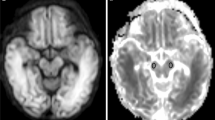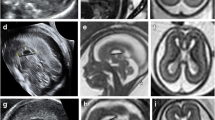Abstract
Background
Literature regarding callosal injury after hypoxic-ischemic injury (HII) is scant.
Objective
To present the MRI and US findings of callosal injury after HII.
Materials and methods
MRI and US studies of 76 neonates were evaluated for HII and 53 were considered positive.
Results
Of the 53 neonates with HII, 40 demonstrated restricted diffusion on DWI; of these, 30 revealed callosal involvement. Nine of the 13 neonates with normal DWI, whose routine MRI images were compatible with HII, were imaged after 1 week of age. Five out of ten neonates imaged during the 1st week of life who did not show callosal restriction on DWI had predominantly basal ganglia injury. Callosal US images were regarded as abnormal in 16 out of the 53 neonates with HII, 15 of which revealed concomitant restricted diffusion on DWI.
Conclusion
Callosal injuries are common after HII. DWI is effective in confirming these injuries and easily demonstrates injury if performed prior to 1 week of age. The restricted diffusion demonstrated after this time could be attributed to continued injury. US is not a sensitive modality for callosal injury detection; however, abnormally increased callosal echogenicity might be a specific marker of injury in this setting.





Similar content being viewed by others
References
van Handel M, Swaab H, de Vries L et al (2007) Long-term cognitive and behavioral consequences of neonatal encephalopathy following perinatal asphyxia: a review. Eur J Pediatr 166:645–654
Rennie JM, Hagmann CF, Robertson NJ (2007) Outcome after intrapartum hypoxic ischaemia at term. Sem Fetal Neonatal Med 12:398–407
Barkovich AJ (2006) MR imaging of the neonatal brain. Neuroimaging Clin N Am 16:117–135, viii-ix
Huang BY, Castillo M (2008) Hypoxic-ischemic brain injury: imaging findings from birth to adulthood. Radiographics 28:417–439, quiz 617
Heinz ER, Provenzale JM (2009) Imaging findings in neonatal hypoxia: a practical review. AJR 192:41–47
Volpe JJ (2003) Cerebral white matter injury of the premature infant – more common than you think. Pediatrics 112:176–180
Davatzikos C, Barzi A, Lawrie T et al (2003) Correlation of corpus callosal morphometry with cognitive and motor function in periventricular leukomalacia. Neuropediatrics 34:247–252
Panigrahy A, Barnes P, Robertson R et al (2005) Quantitative analysis of the corpus callosum in children with cerebral palsy and developmental delay: correlation with cerebral white matter volume. Pediatr Radiol 35:1199–1207
Benjak V, Culjat M, Pavlovic M et al (2008) Changes of the corpus callosum in children who suffered perinatal injury of the periventricular crossroads of pathways. Coll Antropol 32(Suppl(1)):25–29
Moses P, Courchesne E, Stiles J et al (2000) Regional size reduction in the human corpus callosum following pre- and perinatal brain injury. Cereb Cortex 10:1200–1210
Wolf RL, Zimmerman RA, Clancy R et al (2001) Quantitative apparent diffusion coefficient measurements in term neonates for early detection of hypoxic-ischemic brain injury: initial experience. Radiology 218:825–833
Takenouchi T, Heier LA, Engel M et al (2010) Restricted diffusion in the corpus callosum in hypoxic-ischemic encephalopathy. Pediatr Neurol 43:190–196
Friese SA, Bitzer M, Freudenstein D et al (2000) Classification of acquired lesions of the corpus callosum with MRI. Neuroradiology 42:795–802
Epelman M, Daneman A, Kellenberger CJ et al (2010) Neonatal encephalopathy: a prospective comparison of head US and MRI. Pediatr Radiol 40:1640–1650
Daneman A, Epelman M, Blaser S et al (2006) Imaging of the brain in full-term neonates: does sonography still play a role? Pediatr Radiol 36:636–646
Babcock DS (1984) The normal, absent, and abnormal corpus callosum: sonographic findings. Radiology 151:449–453
Melhem ER (2002) Time-course of apparent diffusion coefficient in neonatal brain injury: the first piece of the puzzle. Neurology 59:798–799
Haynes RL, Billiards SS, Borenstein NS et al (2008) Diffuse axonal injury in periventricular leukomalacia as determined by apoptotic marker fractin. Pediatr Res 63:656–661
Zhang J, Liu J, Katafiasz B et al. (2011) HIV-1 gp120-induced axonal injury detected by accumulation of β-amyloid precursor protein in adult rat corpus callosum. J Neuroimmune Pharmacol 2 Feb [Epub ahead of print]
Skranes JS, Martinussen M, Smevik O et al (2005) Cerebral MRI findings in very-low-birth-weight and small-for-gestational-age children at 15 years of age. Pediatr Radiol 35:758–765
Maneru C, Junque C, Salgado-Pineda P et al (2003) Corpus callosum atrophy in adolescents with antecedents of moderate perinatal asphyxia. Brain Inj 17:1003–1009
Hoon AH Jr (2005) Neuroimaging in cerebral palsy: patterns of brain dysgenesis and injury. J Child Neurol 20:936–939
Coley BD, Hogan MJ (1997) Cystic periventricular leukomalacia of the corpus callosum. Pediatr Radiol 27:583–585
Nagy Z, Lindstrom K, Westerberg H et al (2005) Diffusion tensor imaging on teenagers, born at term with moderate hypoxic-ischemic encephalopathy. Pediatr Res 58:936–940
Yeatman JD, Ben-Shachar M, Bammer R et al (2009) Using diffusion tensor imaging and fiber tracking to characterize diffuse perinatal white matter injury: a case report. J Child Neurol 24(7):795–800
Anjari M, Srinivasan L, Allsop JM et al (2007) Diffusion tensor imaging with tract-based spatial statistics reveals local white matter abnormalities in preterm infants. Neuroimage 35:1021–1027
Domi T, deVeber G, Shroff M et al (2009) Corticospinal tract pre-Wallerian degeneration: a novel outcome predictor for pediatric stroke on acute MRI. Stroke 40:780–787
Kontis D, Catani M, Cuddy M et al (2009) Diffusion tensor MRI of the corpus callosum and cognitive function in adults born preterm. Neuroreport 20:424–428
Chan KC, Khong PL, Lau HF et al (2009) Late measures of microstructural alterations in severe neonatal hypoxic-ischemic encephalopathy by MR diffusion tensor imaging. Int J Dev Neurosci 27:607–615
Righini A, Doneda C, Parazzini C et al (2010) Diffusion tensor imaging of early changes in corpus callosum after acute cerebral hemisphere lesions in newborns. Neuroradiology 52:1025–1035
Ward P, Counsell S, Allsop J et al (2006) Reduced fractional anisotropy on diffusion tensor magnetic resonance imaging after hypoxic-ischemic encephalopathy. Pediatrics 117:e619–630
Liauw L, van der Grond J, van den Berg-Huysmans AA et al (2008) Hypoxic-ischemic encephalopathy: diagnostic value of conventional MR imaging pulse sequences in term-born neonates. Radiology 247:204–212
Chepuri NB, Yen YF, Burdette JH et al (2002) Diffusion anisotropy in the corpus callosum. AJNR 23:803–808
Hynd GW, Hall J, Novey ES et al (1995) Dyslexia and corpus callosum morphology. Arch Neurol 52:32–38
Nosarti C, Rushe TM, Woodruff PW et al (2004) Corpus callosum size and very preterm birth: relationship to neuropsychological outcome. Brain 127:2080–2089
Author information
Authors and Affiliations
Corresponding author
Rights and permissions
About this article
Cite this article
Epelman, M., Daneman, A., Halliday, W. et al. Abnormal corpus callosum in neonates after hypoxic-ischemic injury. Pediatr Radiol 42, 321–330 (2012). https://doi.org/10.1007/s00247-011-2238-5
Received:
Revised:
Accepted:
Published:
Issue Date:
DOI: https://doi.org/10.1007/s00247-011-2238-5




